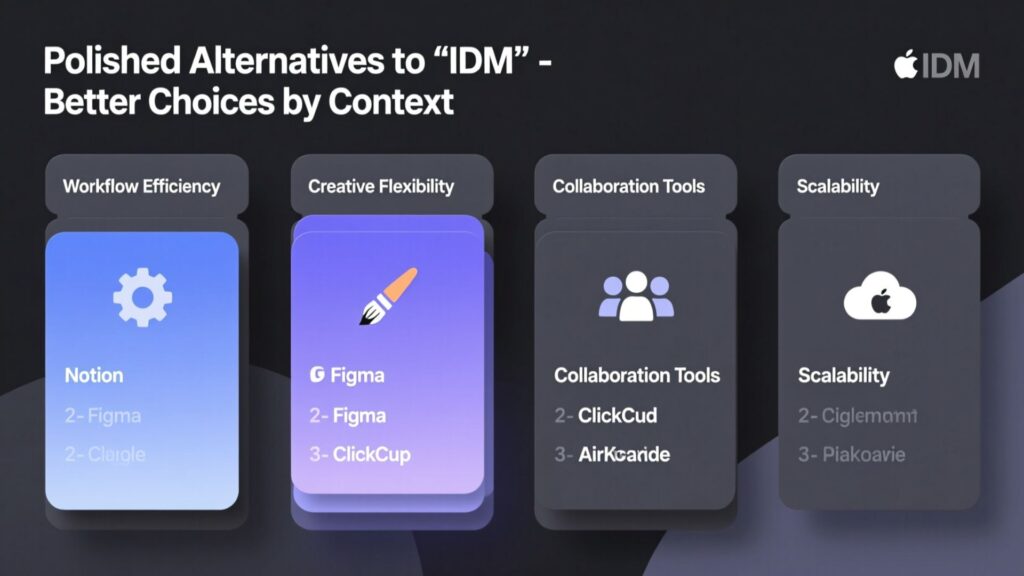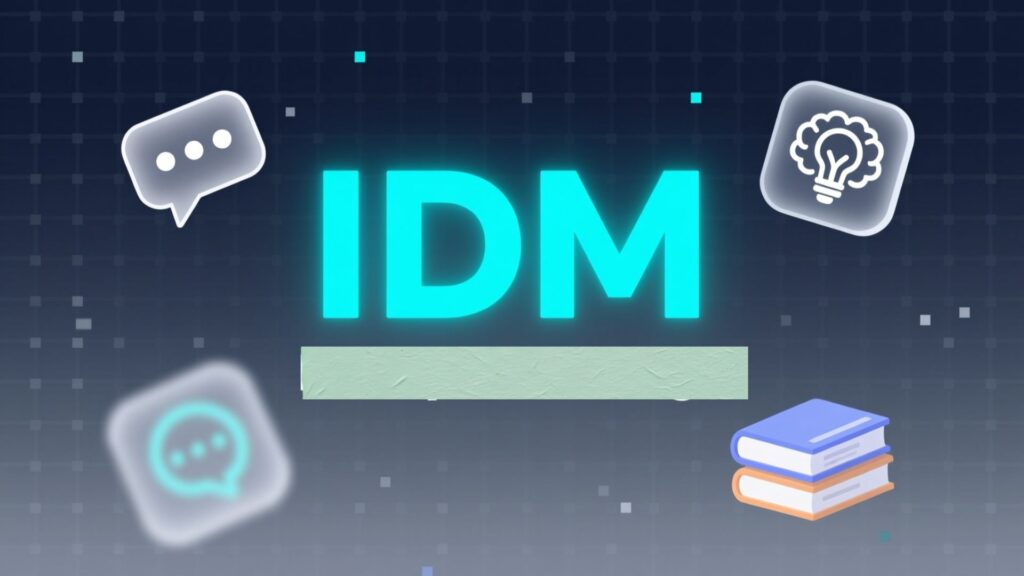Texting evolves fast. New slang, new acronyms, and new connotations pop up nearly every year. One acronym you’ll see often now is IDM. But what exactly is idm meaning in text, and how should you use it or avoid it to get your tone right?
In this deep-dive post, you’ll learn:
- idm meaning text and its core definition
- How “IDM” appears in real conversation
- When to use it and when not to
- How tone shifts meaning
- Smarter alternatives (for casual, formal, friendly styles)
- A decision guide for choosing the best phrase
- The subtle communication dynamics behind one short acronym
Let’s get into it.
What IDM Means in Texting

When you see IDM in a chat, it most often stands for “I Don’t Mind.”
In casual texting, it signals flexibility: you don’t care which option happens. It’s the text equivalent of shrugging and saying, “Either one works for me.”
“Do you want pizza or burgers?”
“IDM. Either’s fine.”
Sometimes, people also interpret IDM to mean “It Doesn’t Matter.” That sense is very close in practice that you’re neutral, not strongly favoring any side.
Other Meanings (Outside Texting)
It’s worth knowing that IDM can mean different things in other contexts. But in a text conversation, these are less likely:
- Intelligent Dance Music (a genre of electronic music)
- Internet Download Manager (software)
- Various technical or corporate acronyms (identity management, integrated data management, etc.)
Unless someone’s talking about music, downloads, or IT, you can safely assume idm meaning in text = “I don’t mind.”
Real-World Usage Examples of “IDM”
Seeing how “IDM” behaves in real chats helps you sense its tone, pitfalls, and flexibility. These examples also show how punctuation, context, or added words shift its meaning.
| Chat Context | Message | Interpretation / Tone |
|---|---|---|
| Friend making plans | “We can go to the cafe or the park. IDM.” | You’re okay with either neutral flexibility |
| Suggestion in group | “Do you want 1 PM or 2 PM call?” → “IDM, whatever works for others.” | Cooperative, letting group decide |
| Between lovers | “Should I pick movie?” → “IDM.” | Could read as detached if short |
| With emoji | “IDM 😊” | Friendly, lighthearted |
| With follow-up | “IDM you decide what sounds fun.” | Warm, encouraging |
| Harsh context | “You pick. IDM.” | Feels cold, dismissive |
Mini case study
Two friends, Sam and Jordan, plan a weekend hangout by text:
- Sam: “Do you want to go to the beach or the mountains?”
- Jordan: “IDM.”
Sam suggests beach; Jordan later replies “cool.”
In another version:
- Sam: “Beach or mountains?”
- Jordan: “IDM.”
- Sam: “Okay, beach!”
- Jordan: “Fine.”
That “Fine.” added on makes Jordan sound resentful rather than easygoing. Tone and follow-up matter.
When to Use “IDM” (✅ Appropriate)
“IDM” works best when:
- You genuinely have no strong preference.
- You want to be agreeable without over-committing.
- You’re chatting informally (friends, peers, casual conversations).
- You want to let the other person lead when the choice is minor.
Examples:
- Plans: “Lunch at noon or 1? IDM.”
- Group decision: “Which movie? IDM, you pick.”
- Flexible choice: “Red or black shirt? IDM, both are nice.”
- Day plans: “Coffee or smoothie? IDM, your call.”
Using IDM in those contexts says: I trust you, I’m easygoing. It keeps the conversation smooth.
When “IDM” Backfires (❌ Avoid In)
There are times when “IDM” either fails you or makes things worse. Avoid using “IDM” in:
- Professional or formal settings (work emails, client texts).
- Situations where your opinion matters (e.g. decisions about budgets, relationships).
- When the person is seeking emotional support or reassurance.
- When “neutral” sounds like you don’t care e.g., “Do you want to break up?” → “IDM” is harsh.
- Important or serious matters, where clarity or commitment is needed.
Examples to avoid:
- Boss: “Should I make the changes now or later?” → “IDM.”
- Your partner: “Do you want to go with me?” → “IDM.”
- Someone seeking advice: “Which path should I pick?” → “IDM.”
Here “IDM” can come across as lazy, cold, or dismissive.
Tone Matters: How “IDM” Can Be Perceived
The same text “IDM” can feel very different depending on tone, context, or punctuation. Let’s break down three major tone categories.
Neutral / Friendly
You’re being cooperative, easygoing, casual. The recipient knows you’re fine with options.
- “IDM, whatever you like.”
- “IDM 😊”
- “IDM, don’t worry about it.”
This tone works well in low-stakes, friendly conversations.
Detached / Indifferent
You use “IDM” but without warmth or follow-up. The lack of emotional signal makes it feel flat.
- “IDM.”
- “IDM w/e.” (with “w/e” = whatever)
- “IDM your choice.”
Here, your emotional involvement seems minimal.
Passive-Aggressive
You mean something more than “I don’t mind,” and your tone conveys irritation or resentment.
- “IDM, do what you want.”
- “IDM, whatever.”
- “Fine. IDM.”
That extra edge in phrasing communicates frustration under sly guise.
| Tone Type | Example | Perceived Emotion |
|---|---|---|
| Neutral / Friendly | “IDM 😊” | Cooperative, casual |
| Detached | “IDM.” | Noncommittal, cold |
| Passive-Aggressive | “IDM, whatever…” | Annoyed, resentful |
Tip: Add context or warmers (emojis, extra words) when using “IDM” to avoid misinterpretation.
Polished Alternatives to “IDM” – Better Choices by Context

Sometimes “IDM” isn’t the right tone or you want to sound clearer. Below are categorized alternatives that convey a similar meaning but with added nuance.
Formal / Polite Alternatives
Use these in semi-formal or work-adjacent settings:
- “I’m fine with either.”
- “That works for me.”
- “I have no strong preference.”
- “I’m okay with whatever you choose.”
These retain flexibility but sound more professional and respectful.
Friendly / Cooperative Alternatives
For social settings where you want warmth:
- “Whatever works best for you!”
- “I’m good either way.”
- “You decide :)”
- “I’m okay with that.”
These add warmth, friendliness, and inclusion.
Relaxed / Informal Alternatives
When chatting casually:
- “Sure thing.”
- “No big deal.”
- “All good!”
- “No worries.”
- “Up to you.”
These feel lightweight and conversational.
12 Refined Ways to Say “IDM” – With Examples
Let’s get practical. Here are 12 stronger alternatives to “IDM”, each with a tone note and example.
| Alternative | Tone | Example Use |
|---|---|---|
| “That works for me.” | Polite | “Meeting at 3 or 4? That works for me.” |
| “I’m okay with either.” | Neutral | “Should we watch A or B? I’m okay with either.” |
| “Whatever you decide.” | Cooperative | “Plan or movie whatever you decide, I’m in.” |
| “You choose :)” | Friendly | “Dinner spot? You choose :)” |
| “I don’t have a preference.” | Formal-ish | “Red or blue? I don’t have a preference.” |
| “All good!” | Casual | “Cinema or home? All good!” |
| “No worries.” | Chill | “We can meet later or earlier no worries.” |
| “Up to you.” | Easygoing | “Up to you I wasn’t set on anything.” |
| “I’m flexible.” | Slightly more assertive | “Time can be 5 or 6 I’m flexible.” |
| “Either works.” | Direct | “Either works. Pick what’s easiest.” |
| “No big deal.” | Casual | “Wear sneakers or boots? No big deal.” |
| “Works for me.” | Simple | “Conference call at 2? Works for me.” |
These options let you control tone more softly than “IDM” alone.
Choosing the Right Phrase: A Quick Guide
When you’re in a conversation, which phrase should you use? Here’s a decision guide.
| Situation | Best Option | Avoid “IDM” When |
|---|---|---|
| Casual text with friends | “All good!” or “No worries” | You want extra warmth or personality |
| Semi-formal chat or work | “That works for me” | A more formal tone is needed |
| Sensitive topic / emotional | “I’m fine with…” + context | Words that are too brief may feel cold |
| You want to let them lead | “Whatever you decide” | You don’t want to show weak detachment |
Flowchart (in text):
- Are we chatting casually or formally?
- Casual → go informal alternatives
- Formal → choose polite alternatives
- Is the decision low-stakes or high-stakes?
- Low-stakes → you can use more casual phrasing
- High-stakes → prefer clear, warmer phrasing
- Do you care about tone perception?
- Yes → add qualifiers (emoji, “sounds good,” “your call”)
- No → simpler phrasing works
This guide helps you avoid “IDM meaning text message” misfires.
Modern Communication Insight: Why Tone Decodes Intention
Short texts carry more emotional risk than face-to-face speech. Without vocal inflection or facial cues, “IDM” must carry tone through text alone. Linguists call this digital ambiguity.
Key ideas:
- Abbreviation density: The more you shorten, the more emotional nuance you lose.
- Lack of qualifiers: “IDM.” vs “IDM 😊” the emoji or extra phrase gives tone.
- Receiver’s bias: Your reader may already be sensitive and read coldness even if you didn’t intend it.
- Textual pragmatics: In digital speech, including or excluding “please,” “thanks,” and follow-up phrases shifts your meaning greatly.
In short, “IDM” doesn’t just say “I don’t mind.” It communicates “I don’t mind how I feel about this,” and how you feel matters.
Common Misunderstandings About “IDM”
Here are some pitfalls people fall into when using or reading idm meaning in text:
- Assuming “IDM” always means indifference
Sometimes it just means flexibility, not emotional detachment. - Misreading tone
A terse “IDM.” can feel cold even if the sender meant “I’m fine with either.” - Overusing it
If you reply “IDM” to most suggestions, people may think you avoid decisions or don’t care. - Using it in serious matters
In negotiations, relationships, or emotional topics, “IDM” feels lazy or insensitive. - Ignoring context or follow-up
No extra words or context around “IDM” makes it ambiguous.
Anecdote: A friend asked “Dinner or movie?” and got “IDM.” The asker chose movie. Later, when asked if dinner was okay, the friend felt slighted. In private they admitted “IDM” felt passive and unenthusiastic to them. The lack of warmth in text misled the relationship.
IDM in 2025: Evolution and Modern Use
Over years, people have used similar shorthand acronyms: IDC (I Don’t Care), NVM (Never Mind), IDK (I Don’t Know). IDM fits stylistically between “IDC” (too dismissive) and “I don’t mind” (a little long). It’s modern shorthand for flexibility.
Some trends in 2025:
- Increased use in social media DMs, posts, stories
- Lower-case “idm” becoming more common in casual chats
- Use of emojis, stickers, or tone indicators (e.g.
/lh= “light-hearted”) alongside IDM to reduce ambiguity - People more aware of tone risk, so adding qualifiers is more common
Compared to “IDC,” which often carries apathy, IDM is softer. It says, “I don’t mind, I’m okay with this,” rather than “I literally don’t care.”
Final Thoughts: Mastering “IDM” and Its Alternatives
- idm meaning in text = I Don’t Mind, usually.
- The meaning shifts with tone: friendly, detached, or passive-aggressive.
- Use “IDM” when you’re truly flexible especially in casual chats.
- Avoid using it when clarity, warmth, or seriousness matters.
- Choose alternatives for professional, friendly, or emotional contexts.
- Always check how your reader might interpret brevity.
Mastering small replies like “IDM” is less about the letters and more about emotional nuance. When you know your audience and add just the right warmth or context, you’ll never leave people guessing.
Bugti is the founder of Quoethint.com, a hub for English language tips, writing advice, and grammar guidance. With years of experience in English studies and a passion for clear communication, Bugti created this platform to make grammar and writing easy to understand for everyone.
